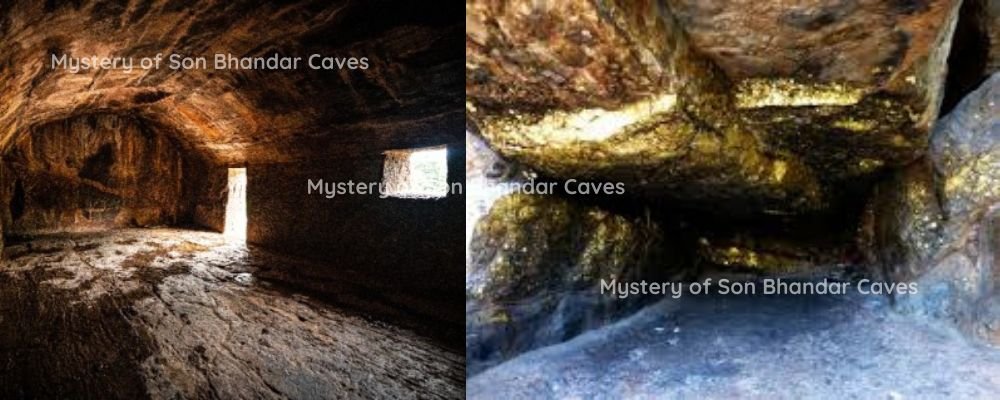The Son Bhandar Caves, also known as Swarn Bhandar (“Storehouse of Gold”), are two ancient man-made caves sculpted into the bottom of the Vaibhar Hills in Rajgir, Bihar. The caves are important for their historical, architectural, and religious significance, especially within Jainism.
Table of Contents
Historical Background
The precise date of the Son Bhandar Caves is a matter of academic controversy. A dedicatory inscription in Gupta script along the entrance of the central cave credits its construction to a Jain monk called Vairadeva and dates it to the 4th century CE. But according to some scholars, the caves date back to the Maurya Empire (approx. 319–180 BCE), judging from the similarity in architecture with the Barabar Caves, including the trapezoidal entrance and vaulted roofs
Architectural Features

There are two primary caves, one intact and the other destroyed in part.
1. Western Cave (Main Cave)
- Structure: Rectangular room with a trapezoidal entrance, like Mauryan-style architecture.
- Ceiling: Vaulted or barrel-shaped.
- Polish: It does not have the Mauryan high-gloss polish, unlike the Barabar Caves.
- Carvings: There are Jain sculptures inside, including:
- A Chaumukha idol (four-faced) featuring four Tirthankaras: Ajitanatha, Sambhavanatha, Shantinatha, and Rishabhanatha.
2. Eastern Cave (Partially Destroyed)
- Condition: Entrance collapsed but interior visible.
- Features: Jain carvings, including:
- A damaged figure of Lord Mahavira, the 24th Tirthankara.
Religious Significance
- They are among the oldest specimens of Jain architecture.
- The monks of Jain used them as shelters and meditation centers.
- They are still places of religious significance and are visited by pilgrims, particularly on Jain festivals.
Best time to visit Son bhandar caves
October to March
- Comfortable temperatures: 10°C to 25°C, ideal for walking, sightseeing, and trekking around the Vaibhar Hills.
- Clear skies: Ideal for photography and basking in Rajgir’s hill and valley scenery.
- Less rainfall: Dry season minimizes the danger of slippery trails or mucky paths.
Festivals and Cultural Attractions
- Rajgir Mahotsav (December): A festival of local music, dance, and crafts — a lively time to come.
- Jain festivals: Such events as Mahavir Jayanti tend to bring pilgrims into the caves and surrounding Jain sites.
Avoid Visiting:
- Summer (April to June): Extremely hot, with temperatures crossing 40°C+.
- Monsoon (July to September): Heavy rains will make the rocky trails slippery and can hamper travel.
How to Reach Son Bhandar Caves
1. By Train
a. Nearest Railway Station:
- Rajgir Railway Station (RGD) – around 2.5 km from the caves
- Good connectivity with major cities such as Patna, Gaya, and Nalanda
b. From the station:
- Take an auto-rickshaw or cycle-rickshaw to the Vaibhar Hills/Son Bhandar Cave area
- You may also walk if you don’t mind taking a scenic 20–25 minute walk
2. By Air
a. Nearest Airports:
- Gaya International Airport (GAY) – around 75 km
- Patna Airport (PAT) – around 100 km
b. From either airport:
- Rent a taxi or take a bus/train to Rajgir
3. By Road
a. Road Connections:
- Rajgir is road-connected to the surrounding cities:
- Patna: ~100 km
- Gaya: ~75 km
- Nalanda: ~15 km
- Bodh Gaya: ~90 km
b. Bus Services:
- Regular services to Rajgir are run by Bihar State Road Transport Corporation (BSRTC) and private buses
Buddhist and Historical Sites Near Son Bhandar Caves
1. Venuvana (Bamboo Grove)
- Presented by King Bimbisara to the Buddha.
- One of the earliest Buddhist monasteries (viharas)
2. Vulture’s Peak (Gridhakuta Hill)
- Distance: Begins at the foot of Ratnagiri Hill.
- Why Visit: One of India’s oldest ropeways, it provides a picturesque trip to the stupa and surrounding destinations.
- More About Vulture’s Peak
3. Hot Springs at Rajgir
- Holy to Hindus as well as Buddhists.
- Believed to have curative powers.
4. Nalanda University Ruins
- Only 15 km from Rajgir.
- Previously one of the greatest centers of learning in the ancient world.
More Places to visit in Rajgir
Opening Hours of Son bhandar caves
- Daily: 9:00 AM to 5:00 PM
- Last Entry: Typically around 4:30 PM, in order to provide enough time for visitors to see everything before closing.
Tips for Visiters:
- Late morning or early afternoon is time to escape the heat and obtain improved light for photography.
- Wear sturdy walking shoes — the trail features rough ground and gentle climbs.
- Local tour guides are usually present near the location to describe the history and myths of the caves.
Summary of Son Bhandar Caves
| Feature | Details |
| Location | Rajgir, Bihar |
| Built By | Jain monk Vairadeva (Gupta period) |
| Affiliation | Jainism |
| Architecture | Rock-cut, trapezoidal entrance, barrel roof |
| Notable Legends | Secret treasure of King Bimbisara, British cannon failure |
| Religious Use | jain meditation place, residence of Tirthankara carvings |
| Status | Heritage and tourist destination |
FAQ’s About Son Bhandar Caves
1. What are the Son Bhandar Caves?
The Son Bhandar Caves are old rock-cut caves hewn into the Vaibhar Hills at Rajgir. They are believed to be connected with Jainism and to have been built in the Gupta period (4th century CE), but some think they are even older.
2. Is there really treasure inside the caves?

No treasure has been proven. The legend is still a local legend and contributes to the site’s mystique.
3. Did the British try to open the cave?
Yes, it’s said that British soldiers shot a cannon at part of the cave wall to try and find the treasure. Cannonball imprints remain.
4. Is there an entry fee?
No, entry to the Son Bhandar Caves is free of charge.
5. Are there guides available?
Yes, local guides are frequently present at the site to guide visitors through the history and mythology of the caves.



